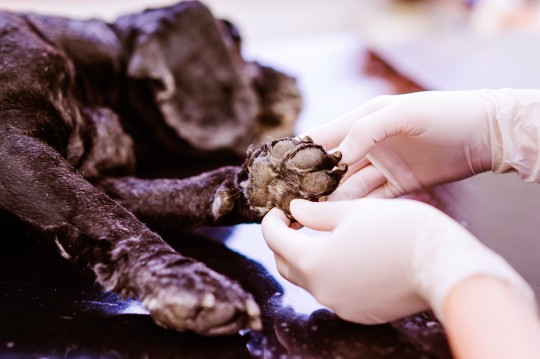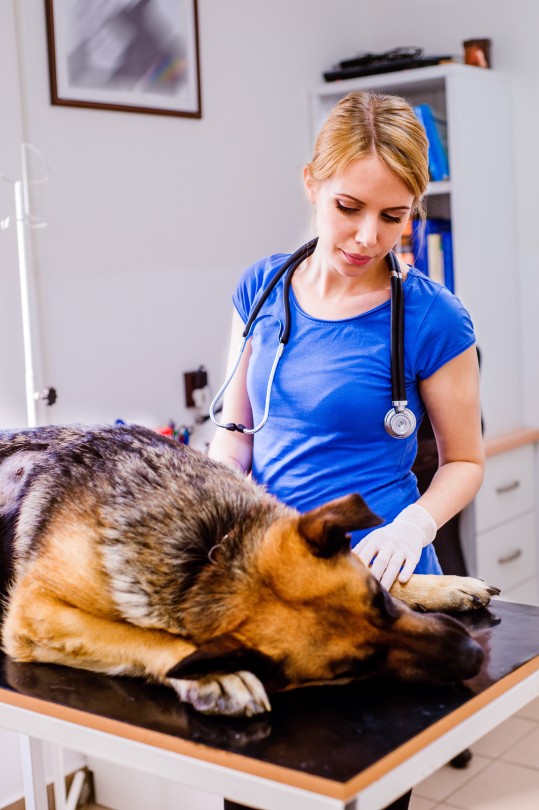Text
Nutritional Support for Dogs with CCL Tears

Providing proper nutrition is crucial for dogs recovering from CCL (cranial cruciate ligament) tears. This article explores the role of nutrition in supporting the healing process, enhancing joint health, and promoting overall well-being for dogs affected by CCL injuries.
Understanding CCL Tears in Dogs CCL tears are a common orthopedic injury in dogs, affecting the stability of the knee joint (stifle). When the CCL is torn or ruptured, dogs experience pain, lameness, and reduced mobility. Effective management of CCL tears involves a holistic approach, including proper nutrition to support recovery and joint health.
Importance of Nutrition in CCL Tear Recovery Nutrition plays a vital role in the healing process for dogs with CCL tears. Adequate nutrition supports:
Joint Health: Nutrients like glucosamine, chondroitin, and omega-3 fatty acids help maintain cartilage health and reduce inflammation in the joints.
Muscle Strength: Protein and amino acids support muscle repair and maintenance, aiding in the rehabilitation process.
Weight Management: Maintaining a healthy weight reduces stress on the joints, which is crucial for dogs recovering from CCL injuries.
Key Nutrients for Dogs with CCL Tears Glucosamine and Chondroitin: These compounds are essential for cartilage health and may help reduce joint inflammation and support joint lubrication.
Omega-3 Fatty Acids: Found in fish oil, omega-3 fatty acids have anti-inflammatory properties that can benefit dogs with joint issues, including CCL tears.
Protein: High-quality protein sources (e.g., lean meats, fish, eggs) support muscle repair and strength, essential for dogs undergoing rehabilitation.
Vitamins and Minerals: Antioxidant vitamins (e.g., Vitamin C, Vitamin E) and minerals (e.g., manganese, zinc) support overall joint health and immune function.
Dietary Considerations for Dogs with CCL Tears When selecting a diet for a dog recovering from a CCL tear, consider the following:
Quality Ingredients: Choose dog foods with high-quality ingredients, avoiding fillers and artificial additives.
Joint Support Formulas: Some commercial dog foods are formulated specifically to support joint health, containing added glucosamine, chondroitin, and omega-3 fatty acids.
Weight Management: If your dog is overweight, work with your veterinarian to create a weight management plan to reduce stress on the joints.
Homemade Diets and Supplements While commercial diets formulated for joint health are convenient, some pet owners prefer homemade diets or adding supplements to their dog's food. It's essential to consult with your veterinarian before making significant dietary changes or adding supplements to ensure they are appropriate and safe for your dog's specific needs.
Hydration and Overall Health Ensure your dog has access to fresh, clean water at all times. Proper hydration supports overall health and aids in digestion, nutrient absorption, and joint lubrication.
Monitoring and Adjustments Monitor your dog's weight and overall condition regularly. Adjust their diet as needed based on their recovery progress, activity level, and any recommendations from your veterinarian.
Conclusion Nutritional support plays a vital role in the recovery and long-term management of dogs with CCL tears. By providing a balanced diet rich in essential nutrients, you can help support joint health, promote healing, and improve your dog's overall well-being. Consult with your veterinarian to develop a tailored nutrition plan that meets your dog's specific needs and supports their journey to optimal joint health and mobility.
With proper nutrition and comprehensive care, dogs recovering from CCL tears can enjoy an improved quality of life, with reduced pain and enhanced mobility, allowing them to thrive as active and happy companions.
#dog lovers#ccl tear in dogs#dog health#dog foods#rehabilitation#dog ccl injury#dog injuries#ccl rupture in dogs
0 notes
Text
Signs Your Dog Might Have a CCL Tear: What to Look For

CCL (cranial cruciate ligament) tears are a common orthopedic issue in dogs, causing pain and hindering mobility. Recognizing the signs early can lead to timely treatment and improved outcomes for your canine companion. This article explores the key indicators that your dog may have a CCL tear and what steps you should take if you suspect this condition.
Understanding the CCL and its Importance The cranial cruciate ligament is crucial for stabilizing the knee joint (stifle) in dogs, preventing excessive movement of the tibia relative to the femur during movement. When this ligament tears or ruptures, it leads to instability in the knee joint, causing discomfort and reduced mobility.
Signs of a CCL Tear in Dogs Lameness: One of the most common signs is lameness, where your dog may limp or avoid putting weight on one of their hind legs. The lameness may come on suddenly or develop gradually over time.
Difficulty Rising: Dogs with a CCL tear often struggle to get up from lying down or sitting positions. They may hesitate or show signs of discomfort when attempting to stand.
Swelling: Visible swelling around the knee joint is another indicator of a potential CCL tear. This swelling may be accompanied by heat or tenderness when touched.
Stiffness: Dogs may exhibit stiffness, especially after rest or exercise. They may appear reluctant to move or have difficulty moving fluidly.
Decreased Activity: A dog with a CCL tear may become less active than usual. They may show reluctance to engage in physical activities they previously enjoyed, such as running, jumping, or playing fetch.
Holding Leg Up: Some dogs may hold their affected leg up off the ground when standing or walking, as if trying to minimize weight-bearing on the injured limb.
Audible Signs of Pain: Whimpering, yelping, or vocalizing when moving or when the affected leg is touched may indicate pain associated with a CCL tear.
Breed Predisposition and Risk Factors Certain dog breeds are more prone to CCL tears due to genetic factors or conformational traits. Breeds such as Labrador Retrievers, Golden Retrievers, and Rottweilers are known to have higher incidences of CCL injuries. Additionally, factors like obesity, age, and previous injuries can increase the risk of CCL tears in dogs.
When to Consult a Veterinarian If you notice any of the signs mentioned above or suspect that your dog may have a CCL tear, it's crucial to consult your veterinarian promptly. Early diagnosis and intervention can help alleviate pain, prevent further joint damage, and improve your dog's quality of life.
Diagnosing CCL Tears Your veterinarian will perform a thorough physical examination, assessing your dog's gait, joint stability, and range of motion. Diagnostic tools such as X-rays or advanced imaging techniques like MRI may be recommended to confirm the diagnosis and evaluate the severity of the injury.
Treatment Options Treatment for CCL tear in dogs depends on various factors, including the dog's age, size, overall health, and the severity of the injury. Options may include:
Surgical Intervention: Procedures such as TPLO (Tibial Plateau Leveling Osteotomy), TTA (Tibial Tuberosity Advancement), or extracapsular repair are common surgical options to stabilize the knee joint and promote healing.
Conservative Management: In less severe cases or when surgery is not feasible, conservative management may involve rest, restricted activity, physical therapy, weight management, and anti-inflammatory medications to manage pain and support healing.
Rehabilitation and Prognosis Rehabilitation plays a crucial role in recovery from a CCL tear, regardless of the chosen treatment method. Physical therapy exercises help strengthen the muscles around the knee joint, improve range of motion, and restore mobility. The prognosis for dogs with a CCL tear varies depending on the treatment approach and the individual dog's response to therapy.
Conclusion Recognizing the signs of a CCL tear in your dog early is essential for providing timely veterinary care and improving outcomes. By understanding the symptoms and risk factors associated with CCL tears, pet owners can take proactive steps to ensure their canine companions receive the necessary treatment and support for optimal joint health and overall well-being. If you suspect your dog may have a CCL tear, don't hesitate to consult your veterinarian for a thorough evaluation and personalized treatment plan.
By being vigilant and responsive to changes in your dog's mobility and behavior, you can help them lead a comfortable and active life, free from the discomfort of a CCL injury.
#ccl tear in dogs#cranial cruciate ligament#injuries in dogs#ruptured ccl#ccl tears#pet owners#canine lovers
0 notes
Text
Understanding CCL Tears in Dogs: Causes and Symptoms

CCL (cranial cruciate ligament) tears are a common orthopedic injury affecting dogs, particularly those who are active or overweight. This article delves into the causes, symptoms, and implications of CCL tears in canines, providing valuable insights for pet owners.
What is the CCL? The cranial cruciate ligament (CCL) plays a crucial role in stabilizing the knee joint (stifle) of dogs. Located within the knee, the CCL connects the femur (thigh bone) to the tibia (shin bone), facilitating smooth movement and preventing excessive forward movement of the tibia relative to the femur.
Causes of CCL Tears in Dogs CCL tears can occur due to various factors, including:
Trauma: Sudden twists, falls, or collisions can overstress the ligament, leading to tears. Chronic Degeneration: Long-term wear and tear on the ligament can weaken it over time, making it prone to tearing with minimal force. Genetic Predisposition: Certain breeds are more susceptible to CCL tears, such as Labrador Retrievers, Golden Retrievers, and Rottweilers. Obesity: Excess weight places additional strain on the ligament, increasing the risk of injury. Anatomy: The angle of a dog's knee joint can influence the likelihood of CCL tears. Symptoms of CCL Tears in Dogs Recognizing the signs of a CCL tear early can lead to prompt treatment and better outcomes. Common symptoms include:
Lameness: Sudden or progressive limping, favoring one leg over the other. Swelling: Visible swelling around the knee joint. Difficulty Rising: Reluctance or difficulty getting up from a sitting or lying position. Stiffness: Noticeable stiffness, especially after rest or exercise. Decreased Activity: Reluctance to engage in physical activities that were previously enjoyed. Diagnosing CCL Tears When suspecting a CCL tear, veterinarians typically perform a thorough physical examination, assessing the dog's gait, range of motion, and joint stability. Diagnostic tools such as X-rays or advanced imaging techniques like MRI may be used to confirm the diagnosis and evaluate the severity of the injury.
Treatment Options for CCL Tears Treatment options for CCL tears in dogs depend on the severity of the injury, the dog's age, size, and activity level. Common approaches include:
Surgical Intervention: Surgical procedures like TPLO (Tibial Plateau Leveling Osteotomy), TTA (Tibial Tuberosity Advancement), or extracapsular repair aim to stabilize the knee joint and promote healing. Conservative Management: In less severe cases or for dogs who are poor candidates for surgery, conservative management may involve rest, physical therapy, weight management, and anti-inflammatory medications to alleviate pain and support healing. Prognosis and Rehabilitation The prognosis for dogs with CCL tears varies depending on the chosen treatment method and the individual dog's response to therapy. Surgical intervention often provides the most predictable outcomes, with many dogs returning to near-normal function with proper rehabilitation. Physical therapy, including exercises to strengthen the muscles surrounding the knee joint, is crucial in aiding recovery and preventing future injuries.
Preventing CCL Tears in Dogs While some risk factors like breed predisposition cannot be controlled, steps can be taken to reduce the likelihood of CCL tears in dogs. Maintaining a healthy weight through proper diet and regular exercise helps minimize stress on the joints. Additionally, avoiding high-impact activities and ensuring gradual conditioning for athletic dogs can lower the risk of injury.
Conclusion In conclusion, understanding the causes, symptoms, and treatment options for CCL tears in dogs is essential for pet owners to recognize signs early and seek timely veterinary care. By addressing CCL injuries promptly and effectively, pet owners can improve their dog's quality of life and promote long-term joint health.
By incorporating these insights, pet owners can better understand and manage CCL tears in their beloved canine companions, ensuring they receive the care and attention needed for optimal recovery and future joint health.
1 note
·
View note